Page 1 of 2
Gouldian Color ID
Posted: Tue Feb 22, 2011 12:47 pm
by Ratrodfink
Re: Gouldian Color ID
Posted: Tue Feb 22, 2011 12:49 pm
by L in Ontario
He looks like a definite pastel male but his orange head is the "orangy-ist" I have ever seen on a pastel!


Re: Gouldian Color ID
Posted: Tue Feb 22, 2011 1:38 pm
by MLaRue
I was just thinking the same thing! How cool! I've only seen one like it here and how gorgeous that color is with the pastel blue of the body!

Re: Gouldian Color ID
Posted: Tue Feb 22, 2011 2:33 pm
by nixity
The lighting is off to me but I was leaning towards a Dilute.
It's interesting though because his bib looks white - can you get photos with better lighting? :/
Re: Gouldian Color ID
Posted: Tue Feb 22, 2011 4:30 pm
by CandoAviary
I say it looks like a purple breasted yellow backed hen...??
Better lighting please

Re: Gouldian Color ID
Posted: Tue Feb 22, 2011 5:04 pm
by GOULDYGIRL
Yes, we need better pics, if that's a pastel blue with an orange head like that, I want one!!!!! It almost looks like it has a white body from the pics.
Renee
Re: Gouldian Color ID
Posted: Tue Feb 22, 2011 9:52 pm
by Ratrodfink
I'm going to try and take better pics but the colors in these are pretty accurate. The back is a light silvery blue and the bib is a very light yellow nearly white. It is a hen.
Re: Gouldian Color ID
Posted: Wed Feb 23, 2011 6:30 am
by Teresa
She's beautiful! Where did you get her from?
Re: Gouldian Color ID
Posted: Wed Feb 23, 2011 1:26 pm
by CandoAviary
Ratrodfink wrote:I'm going to try and take better pics but the colors in these are pretty accurate. The back is a light silvery blue and the bib is a very light yellow nearly white. It is a hen.
I could tell that she was a hen but I can see why the others thought it was a male... I have several females with these great orange mask and deep purple breast. The back is definately most interesting. If the lighting is corect than she must be a silver. The amount of dark pigment she retained in the breast and the full, rich mask shows... she must of retained the same degree of malanins in her back color to allow the greys and blues to come through. Most times the hens will be white. Very unique. She is a dark melanin silver hen.
I have never seen this much melanin retained in a silver hen but here are some yellow hens that retained much melanin.... most thought these were males also because of the rich color. I recommend you keep and breed your hen as they produce beautiful colorful chicks

A RH hen:


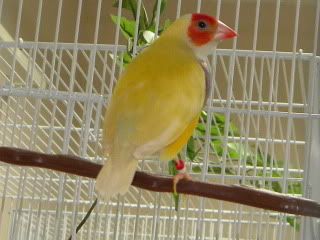
Three in the center are young hens, others male lilac breast
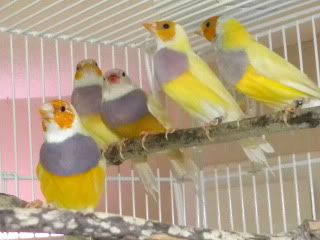
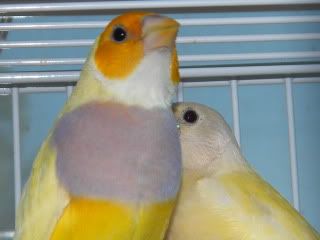
A YH, hen top left right male lilac breast right
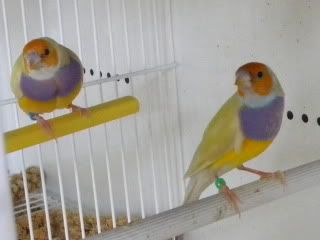
The way to tell these dark melanin hens is by the bibb... the white is the clue. If it were a male the bib would show blue in the case of a single factor and it would be white in the case of a double factor male. But with the double factor male the back would never be that dark.
In this hen you see the white bibb and the greenish yellow of the back. Due to the melanins deposited in the back she looks much like a male's dilute coloration just like your silver hen is diplaying the dark pastel coloration of the back.
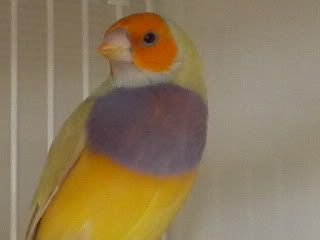
Re: Gouldian Color ID
Posted: Wed Feb 23, 2011 2:05 pm
by Ratrodfink
I actually picked her up at a local bird farm that I happened to pass while going somewhere on business. Thank you so much Candace for all of the great info. The place actually has a very similar male so I might be taking another trip very soon! I do have a beautiful rh-wb-yb male. If I paired them what would they produce?
Re: Gouldian Color ID
Posted: Wed Feb 23, 2011 2:58 pm
by CandoAviary
If the male is a single factor YB and they are both not shoing any hidden genes then this is what you would get (below graph)... this is a great calculator to put in possible pairigs to see what you would get. I would recommend that you pair her with a male that is split for blue or silver. That way you could get more like her, along with blues and silvers.
http://www.amadinagouldove.cz/gouldian- ... /index.php
Oops, I see that this calculator did not transfer what I submittedd. Just pick the males and females head, breast, and body color and hit count...below it will show you all the possible results. Have fun

Re: Gouldian Color ID
Posted: Wed Feb 23, 2011 4:25 pm
by nixity
I really didn't get female from the photos at first but if I'm seeing it now, it almost seems like a pastel sea green - e.g., a Yellow Seagreen bird almost.
I'm specifically looking at the color of the belly - it's pale yellow like a seagreen would be and the back color has that sea green look, but seems almost combined with yellow.
Very interesting indeed but I certainly would like to see more pictures

Re: Gouldian Color ID
Posted: Wed Feb 23, 2011 4:51 pm
by GOULDYGIRL
I'm just in WOW that this hen has pastel looking feathers. If this is a silver hen like Canace was saying and like some Silvers (especially males who have more blue on them, it still doesn't explain the bright orange head. Such an interesting hen. Please take more pics when you can. These birds never cease to amaze me.
Renee
Re: Gouldian Color ID
Posted: Wed Feb 23, 2011 6:01 pm
by CandoAviary
nixity wrote:
I'm specifically looking at the color of the belly - it's pale yellow like a seagreen would be and the back color has that sea green look, but seems almost combined with yellow.
Very interesting indeed but I certainly would like to see more pictures

I would think that if it was a seagreen the mask would be much duller, a more peach color and the back wouldn't be grey/silver.
I too would love to see more pictures...I love the odd balls and she has sparked my curiousity. I have some deep melanin hens that I am going to pair with my silvers.... could be interesting

Re: Gouldian Color ID
Posted: Thu Feb 24, 2011 10:16 am
by nixity
To me because of the lighting the back looks lime greenish - I'd have to see other pictures to see the silvery color other people are seeing, I just don't see it in the photos.
My seagreen birds that I've had and seen didn't have peach colored heads, per se, the heads were pretty much the same hue of orange.
But even in the second picture next to that normal OH you can see a difference in the coloration.















